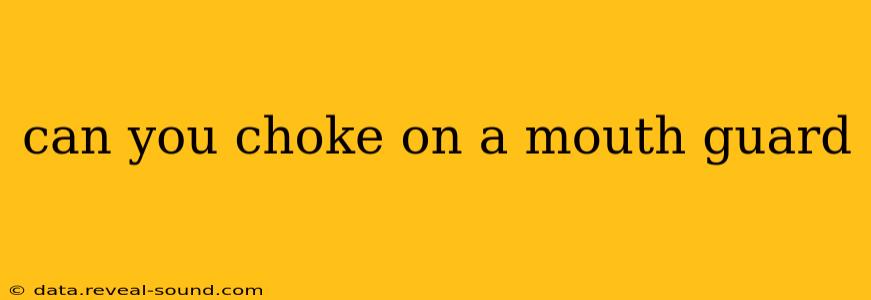Can You Choke on a Mouthguard? Understanding the Risks and Prevention
The short answer is: yes, it's possible to choke on a mouthguard, although it's relatively rare. However, the risk is significantly higher under certain circumstances, and understanding those circumstances is crucial for safe use. This article will explore the potential choking hazards associated with mouthguards, answer common questions, and offer practical advice to minimize the risk.
What are the circumstances that could lead to choking on a mouthguard?
Choking on a mouthguard usually occurs when the guard becomes dislodged during activity and is improperly positioned in the airway. This is more likely to happen during:
- High-impact activities: Sports like boxing, martial arts, or contact sports increase the risk of a mouthguard being knocked out of place.
- Loss of consciousness: If someone loses consciousness while wearing a mouthguard, they may be unable to remove it, potentially leading to airway obstruction.
- Improper fit: A poorly fitting mouthguard that's too large or too small can increase the likelihood of it becoming dislodged and obstructing the airway.
- Children's mouthguards: Young children may be more prone to choking as their airways are smaller and they may not be able to remove the mouthguard easily if it's dislodged.
How can I prevent choking on a mouthguard?
Preventing choking on a mouthguard involves selecting the right type, ensuring proper fit, and understanding safe usage practices.
- Choose the right type of mouthguard: Stock mouthguards are less secure than custom-fitted or boil-and-bite mouthguards. Custom-fitted mouthguards, while more expensive, offer the best fit and minimize the risk of dislodgement. Boil-and-bite options offer a compromise between cost and fit.
- Ensure a proper fit: A mouthguard that fits snugly but comfortably is essential. It shouldn't be so loose that it can easily move around, nor so tight that it restricts breathing or causes discomfort.
- Supervise children: Children should always be supervised while wearing a mouthguard, especially during physical activity. Teach them how to remove the mouthguard safely if it becomes dislodged.
- Appropriate use: Only use mouthguards designed for their intended purpose. Don't use a damaged or worn-out mouthguard.
- Regularly check the mouthguard: Inspect your mouthguard before each use, ensuring that it's in good condition and securely fits.
- Know CPR/First Aid: Knowing basic first aid and CPR is crucial in emergency situations where airway obstruction occurs.
What should I do if someone is choking on a mouthguard?
If someone is choking on a mouthguard, immediately perform the Heimlich maneuver or other appropriate first aid techniques to clear their airway. If the person becomes unconscious, call emergency services immediately and begin CPR. Time is crucial in such situations.
Are there different types of mouthguards that pose different choking risks?
Yes, the design and fit of the mouthguard significantly influence the choking risk. Custom-fitted mouthguards are generally safer than stock mouthguards because they offer a more secure fit. Boil-and-bite mouthguards fall somewhere in between, offering a better fit than stock but not as precise as a custom-fit. Damaged or ill-fitting mouthguards of any type pose a greater risk.
What is the best way to choose a mouthguard?
Choosing the right mouthguard involves considering factors like the type of activity, age, and individual preferences. Consult a dentist or sports professional for guidance on selecting the appropriate type and ensuring a proper fit, particularly for children or individuals with specific dental needs.
By understanding the potential risks and implementing preventive measures, individuals can significantly minimize the chance of choking on a mouthguard. Remember, a properly fitted and appropriately used mouthguard is a vital piece of protective equipment, but its safe use remains paramount.
